An Aye-write Guide To Showing Vs. Telling
An aye-write guide to Showing vs. Telling
I’ll bet that if you’ve ever taken an English class or a creative writing class, you’ll have come across the phrase “Show, don’t tell.” It’s pretty much a creative writing staple! Anton Chekov once said “ Don’t tell me the moon is shining. Show me the glint of light on broken glass.” In other words, showing should help you to create mental pictures in a reader’s head.
Showing helps readers bond with the characters, helps them experience the emotions and action more vividly, and helps immerse them in the world you have created. So “show, not tell” is definitely not bad advice - in certain circumstances. But it has its place. More on that later.
So How do I Show?
Dialogue
Thoughts/Feelings
Actions
Visual Details
So instead, of telling me “He was angry”, show me how his face face flushes red, how his throat tightens, how he slams his fist, how he raises his voice, how his jaw clenches, how he feels hot and prickly, how his breathing gets rapid, how his thoughts turn to static, etc.
Instead of telling me “The cafeteria was in chaos”, you could show me someone covered in food and slowly turning crimson, children rampaging under the feet of helpless adults, frenzied shouting, etc.
Handy Hint! Try to avoid phrases like “I heard”, “I felt”, “I smelled”, etc. These are still “telling words” (also known as filters) and may weaken your prose, as your readers could be taken out of the experience and you may lose their attention.
Is Showing Always The Right Thing to Do?
No! Absolutely not! Showing is not always right and telling is not always wrong! It’s important to develop the skill and instinct to know when to use showing and when to use telling, as both can be appropriate in certain occasions.
So, “Show, don’t tell” becomes “Show versus tell”.
What is Showing and Telling?
Showing is “The grass caressed his feet and a smile softened his eyes. A hot puff of air brushed past his wrinkled cheek as the sky paled yellow, then crimson, and within a breath, electric indigo”
Telling is “The old man stood in the grass and relaxed as the sun went down.”
Both of these excerpts are perfectly acceptable to use in your writing! But both do different things, although their meanings are pretty much the same. The first example is immersive, sweeping, visual, engaging. The second example is much more pared back and functional. But both have their places in prose!
Telling is functional. Think about when you tell people things. You tell your children dinner is ready. The news reporter tells you there’s a drop in crime rates. Your best friend tells you she’ll be late because her car broke down on the way to yours. These are brief and mundane moments in everyday life.
So, do these deserve multiple paragraphs with sensory detail and action/feeling/thought for every little thing? Do you need to spend an entire paragraph agonising over a minor detail when there’s a sword dangling (physically or metaphorically) over your MC’s head? No. And I’ll explain why.
When To Use Telling
As before, telling is functional. It’s brief. It’s efficient. It gives a gist of a situation without getting bogged down in detail.
Showing is slow, rich, expansive, and most certainly not efficient!
Here’s an example of some telling:
“Years passed, and I thought of Emily less and less. I confined her to some dark dusty corner of my brain. I had to elbow my memories of her to the side. I was too busy with other things. Finishing school, then university a year later. Life was full and enjoyable. But then, one dark cold September night…”
You can’t show this example, unless you wanted to waste page after page of your MC waking up, going through everyday life, to get to the point your actual story started. If you do that, you will likely kill off any interest a reader would have in your novel and likely, your book itself.
Summing Up
Showing:
Should be used for anything dramatic
Uses thoughts, feelings, dialogue, action, and visual detail
Will likely be used more than telling
Telling:
Can be used for
Delivering factual information
Glossing over unnecessary details
Connecting scenes
Showing the passage of time
Adding backstory (not all at once!)
More Posts from Lune-versatile and Others
Character Development : A Collection of Resources

Patreon || Ko-Fi || Masterlist || Work In Progress
–
Resources
Resources For Creating Characters
Resources For Describing Characters
Resources For Writing The Mafia
Resources For Writing Royalty
Commentary on Social Issues In Writing
General Tips
Guide to Character Development
How To Fit Character Development Into Your Story
Tips on Character Consistency
Designing A Character From Scratch
Making characters for your world
Characters First, Story Second Method
Understanding Your Character
Tips on Character Motivations
31 Days of Character Development : May 2018 Writing Challenge
How To Analyze A Character
Alternative Method of Character Creation
Connecting To Your Own Characters
Interview As Your Characters
Flipping Character Traits On Their Head
Character Driven vs. Plot Driven Stories
Traits
Tips On Writing About Mental Illness
Giving Your Protagonists Negative Traits
Giving Characters Distinct Voices in Dialogue
Giving Characters Flaws
Making Characters More Unique
Keeping Characters Realistic
Archetypes
Writing Good Villains
Creating Villains
Guide to Writing The Hero
Positive Character Development Without Romanticizing Toxic Behavior
Tips on Writing Cold & Distant Characters
Balancing Multiple Main Characters
Creating Diverse Otherworld Characters
Foreshadowing The Villain
–
Masterlist | WIP Blog
If you enjoy my blog and wish for it to continue being updated frequently and for me to continue putting my energy toward answering your questions, please consider Buying Me A Coffee, or pledging your support on Patreon, where I offer early access and exclusive benefits for only $5/month.
Shoutout to my $15+ patron, Douglas S.!
please please please please reblog if you’re a writer and have at some point felt like your writing is getting worse. I need to know if I’m the only one who’s struggling with these thoughts
A Quick Guide to Foreshadowing!
Foreshadowing - a warning or indication of a future event. In literature, it is when an author provides readers with hints or suggestions as to what will happen later in the story.
Foreshadowing can be used to create tension and set expectations as to how the story will play out. Can inspire reader emotions–suspense, unease, curiosity,
Types of Foreshadowing
Chekhov’s Gun The author states something that they want you to be aware of for the future - in the eponymous example, a gun hanging on the wall in an early chapter will be used later.
Prophecy A statement to character/ reader about what will happen in the future. Although sometimes unclear at first, they normally become true by the end.
Symbolism A more abstract way of foreshadowing, often shown through things like objects, animals, images and weather. Often foreshadows change in mood, luck or behaviour.
Flashback/Flashforward When the author needs the reader to know something that happened that doesn’t fit with the current timeline. Often there will be hints/clues for things that the writer wants you to remember/pick up on later.
Red Herring A type of foreshadowing that deliberately misleads the reader. False clues such as a character finding another suspicious, etc., may lead you to believe one thing when, in reality, they will have done nothing wrong
Tips and Tricks for Effective Foreshadowing!
Don’t foreshadow too obviously - signpost rather than state! Arouse suspicion, but keep them guessing!
If you make a promise, keep it!
The bigger the twist, the earlier it should be foreshadowed! Foreshadowing too soon is essentially a spoiler
Keep foreshadowing in moderation
Use beta-readers - sometimes our foreshadowing feels so obvious to us but it may not to other people who aren’t as close!
Finish Your Drafts (please)
I have this really bad habit of getting most the way through a draft, seeing how it needs to change structurally and… starting a new one. I have countless unfinished drafts and shorts and written out ideas that haunt me with their cut off sentences and half paragraphs.
Here’s the part that sucks. Finishing a draft is always worth it. Always. No matter how messed up your beginning may be, how much you need to rework or change, how much just isn’t coming together. Get through to the end, even if you have to write a bunch of stuff you aren’t proud of to get there, get through to the end.
I learned more about my novel from one finished draft than I did from the five unfinished ones after it. You need to explore your ending, because your ending is the most important part of the entire piece.
This month we explored outlining and character arcs—all of that planning, all of that work we’ve put into this project leads up to the ending. The ending will tell you more about your direction and how the pieces you’ve tried to put together are working than anything else. It’s the one place you can’t hide. Either the ending wraps up how you want it to, or you need to go back to the drawing board.
I almost didn’t finish that one draft. I knew there was a huge gaping problem I hadn’t noticed before right in the middle and that I had to rework some stuff. I nearly stopped there, but I pushed forward instead. It was there that I discovered a large part of that problem was the ending I had planned. I was working towards the wrong thing, so of course the middle would fall apart.
You’ll be able to see your character arcs, your theme, your subplots, all of it needs to be addressed in the ending, so your ending is going to tell you what is working and what isn’t.
Push through to the finish line. Best case scenario you understand your work and process on a deeper level. Worst case, you have a finished draft—and that’s always something to be proud of.
Good luck! Happy end of February. Next month we’ll be talking about some other ways to create characters and voice, amongst other things. I’m looking forward to it!
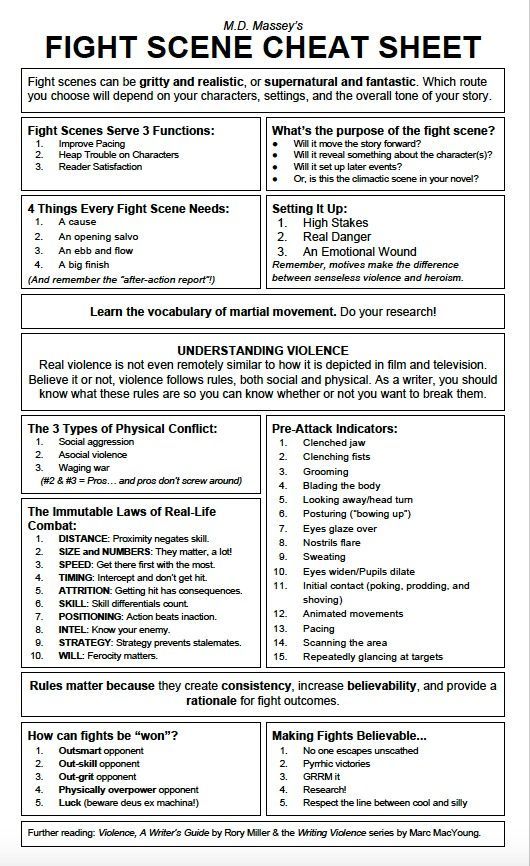
Writing tool for your fight scenes.
I hate to say this, and like, rain on everyone’s parade, but after scrolling past three posts about it on a writing tag …
If you are looking up synonyms to exchange words out in your story with the purpose of sounding smarter, more sophisticated, or complicated to your reader, you are probably abusing the thesaurus.
Now, if you *want* to do this, I mean, you can write whatever or however you want! But I just want you to know that this is frowned upon if you are trying to write at a professional level.
I have an old article on this somewhere …


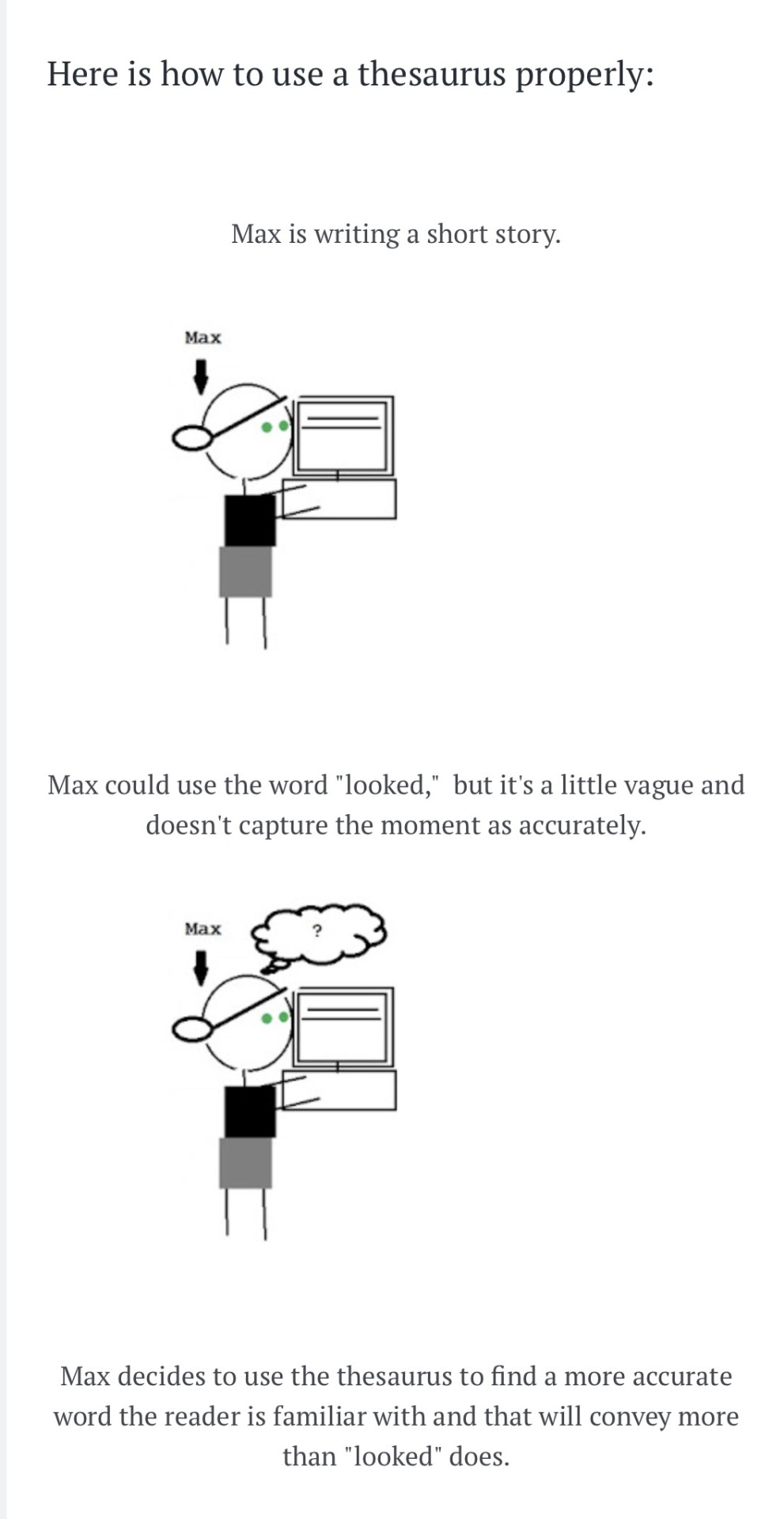
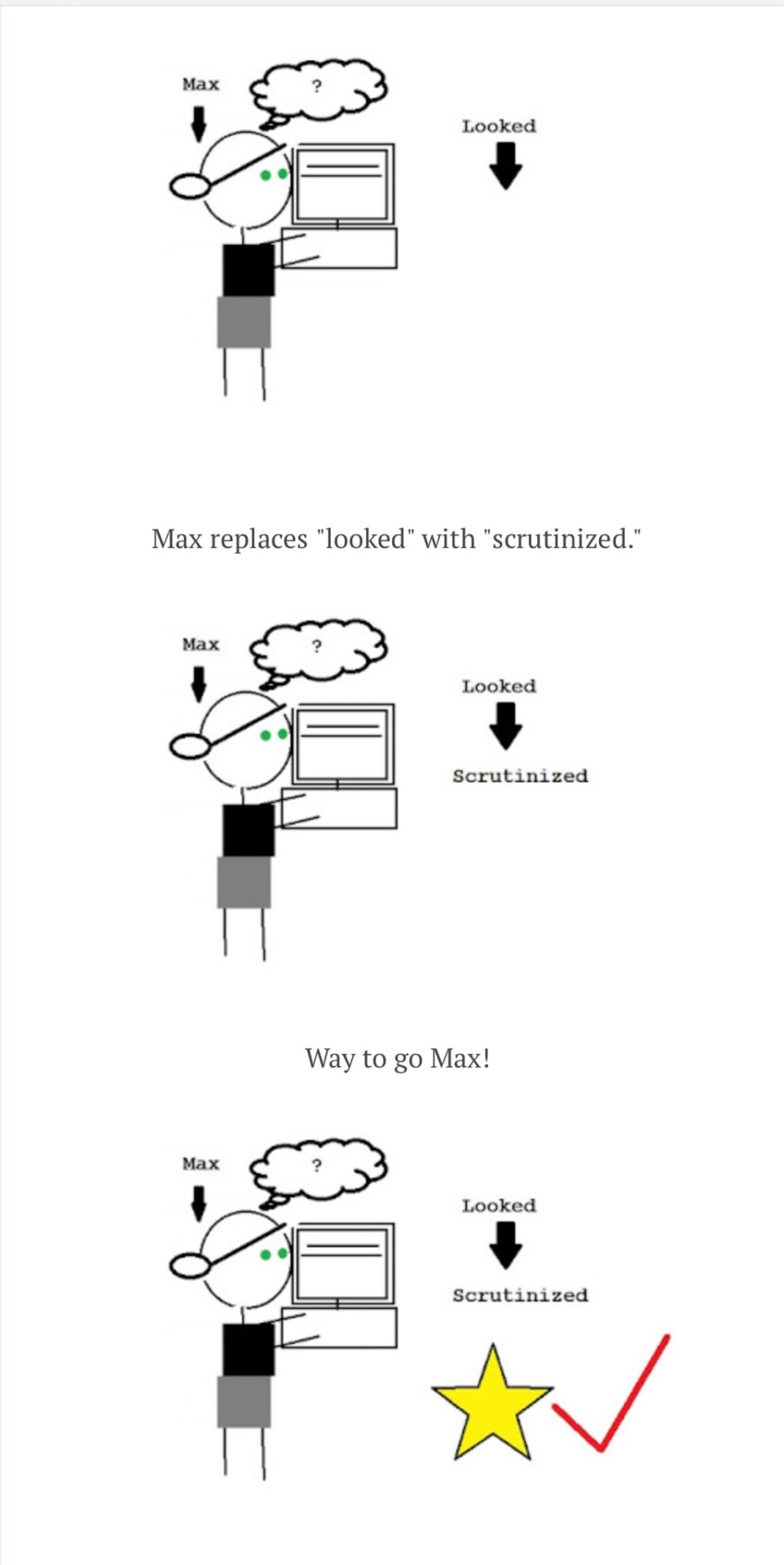
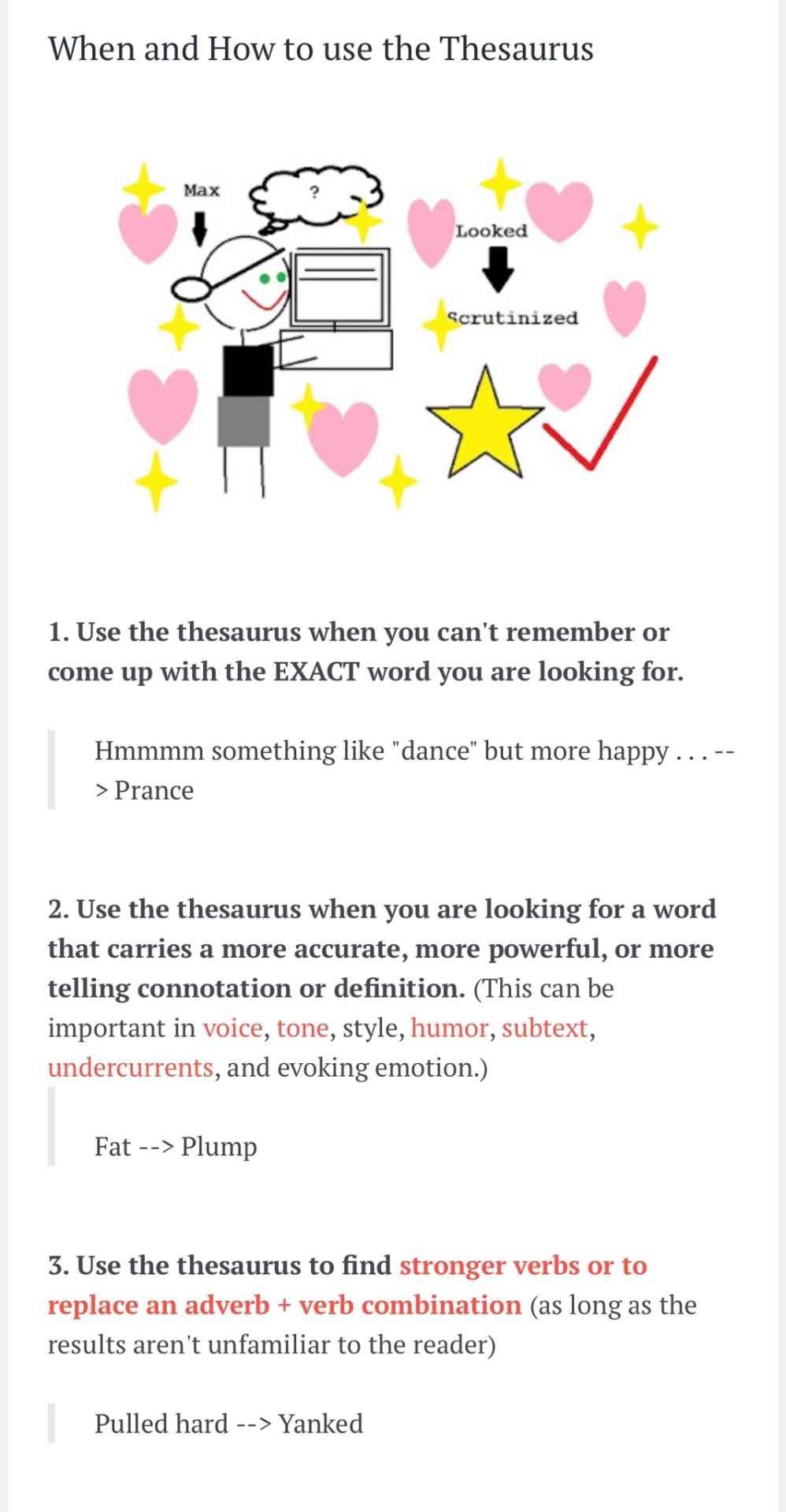

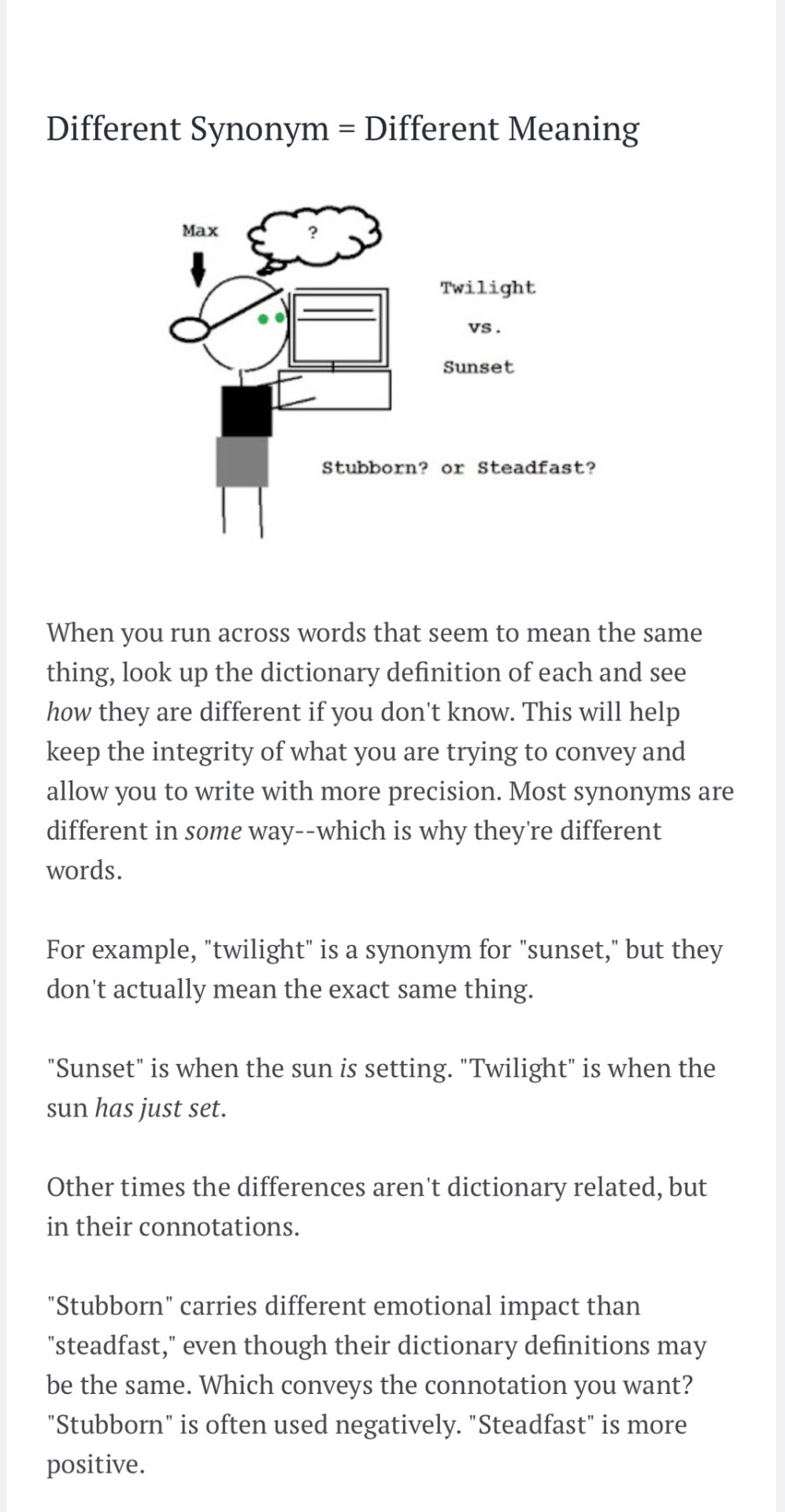
If you want to look at the original article…
https://www.septembercfawkes.com/2018/08/how-to-use-thesaurus-properly.html

How do I write a dream sequence that actually feels dreamy and not just confusing or random? I want it to make sense in the story but still have that weird, surreal vibe dreams have.
Before writing a dream sequence, ask yourself: Why is this dream important?
A strong dream sequence serves a narrative purpose. It either reveals something critical about the character or moves the plot forward. For example, it might:
Highlight a character’s inner conflict, such as self-doubt or guilt.
Offer insight into a character’s fears, desires, or memories.
Foreshadow future events.
Explore the story’s themes.
Present an epiphany or realisation that changes the narrative direction.
When you define the purpose of the dream, you give it meaning and ensure it doesn’t feel like a random, disconnected scene.
Vivid imagery and sensory details
Dreams are often hyper-real or surreal. To truly immerse readers, fill your sequences with vivid imagery. Describe not just what the character sees, but also what they hear, smell, and feel. For example:
The air might feel oppressively heavy, as if the character is moving through water.
Colours could be unnaturally bright or pulsing, creating a sense of unease or wonder.
Sounds may echo strangely, or voices may change tones mid-sentence.
Sensory details are your best friend when crafting dreams. They help you draw readers into the scene, making the dream feel almost tangible without being constrained to what is possible.
The power of symbolism
Dreams are often symbolic, reflecting a character’s subconscious thoughts and emotions. A dream sequence offers a fantastic opportunity to use metaphors and symbols to deepen your narrative. For instance:
A crumbling staircase may represent a character’s feelings of insecurity.
A recurring image, like a locked door, could hint at a secret the character is repressing.
Objects or people in the dream might represent aspects of the character’s personality or unresolved relationships.
By embedding symbols, you can subtly communicate deeper layers of meaning to your readers while building suspense without having to state things outright.
Heightened emotion
In dreams, emotions are often exaggerated. A minor embarrassment can swell into overwhelming shame, and a fleeting joy might feel like euphoria. Use this to your advantage to explore your character’s emotional state. For instance:
A character struggling with grief might dream of a loved one, only for them to disappear when approached.
A character racked with guilt could find themselves pursued by shadowy figures.
Striking a balance between disorientation and logic
Dreams are naturally disorienting because they don’t follow the logical flow of reality. You can introduce elements like sudden scene changes, nonsensical dialogue, or impossible physics to create a truly dreamlike experience. For example:
A character might start at a family dinner, only to inexplicably swimming in an ocean of stars.
A trusted friend might appear with the face of a stranger.
Despite the inherent chaos of dreams, your sequence should still have some degree of narrative coherence. A good rule of thumb is to maintain a logical thread that allows the dream to fulfil its narrative purpose, even if the details are illogical.
Establishing atmosphere
The tone and atmosphere of your dream sequence should align with its purpose. Focus on creating a specific emotional response:
For a nightmare, use eerie, oppressive details, like a pulsating fog or distorted, echoing voices.
For a whimsical dream, evoke wonder with surreal and magical details, such as floating landscapes and shimmering light.
Choose your atmosphere carefully to enhance the emotional impact of the scene.
Types of dream sequences to explore
There are many types of dream sequences, and each serves a unique purpose. Here are some of the most common:
Foreshadowing dreams: These hint at future events, creating suspense or intrigue.
Nightmares: These reveal a character’s fears or anxieties.
Fantasy dreams: These involve magical or surreal elements, and are often used to explore themes, symbols, or metaphors.
Recurring dreams: These underscore unresolved issues or patterns in a character’s life.
Lucid dreams: These allow the dreamer to be aware they’re dreaming and possibly influence the dream’s outcome.
Realisation dreams: These provide moments of clarity or epiphany for the character.
Internal conflict dreams: These visually showcase a character’s inner turmoil, providing a unique way to “show, not tell.”
Linked dreams: These connect two or more characters through shared dreamscapes.
Keep it brief and meaningful
Dream sequences should enhance your story, not derail it. While they offer a chance to be wildly creative, keep them concise and focused. Avoid overloading readers with too much detail or overly prolonged scenes. Your audience should leave the dream sequence full or curiosity, not overwhelmed.
Seamlessly transition in and out
Transitions are crucial for dream sequences. Start with subtle hints, like a sound, a sensation, or a surreal visual that cues readers into the shift from reality to dream. Similarly, exit the dream gracefully, creating a smooth return to the waking world. This ensures that readers are not jarred out of the story.
Writing tips for a dreamlike feel
Use narrative distance to create a floaty, disconnected feeling that mirrors the sensation of dreaming.
Experiment with stream-of-consciousness writing for portions of the dream to mimic the fluid and unpredictable nature of thoughts in sleep.
Pay attention to pacing. Dreams often feel both slow and rapid—a contradiction you can reflect by alternating between drawn-out descriptions and sudden, abrupt moments.
Dream sequences are a space where your imagination can truly run free while still serving the story’s deeper purpose. When done well, they are memorable and meaningful, and leave a lasting impact. It’s a technique well worth exploring.
Creating Fictional Holidays
Every culture and society has holidays! They are often one of the most enjoyable parts of societies and bring people together despite all of their differences. For your story, they are a great way to take your worldbuilding to the next level and make everything feel that much more real. But, Ailey, why does my world even need holidays? Well, personally, holidays are so much fun to create. You can pretty much do whatever you want to do! And, holidays can often provide great opportunitiesfor plots and sub-plots in your story. Holidays can give your characters the opportunity to gather with family, remember the family they lost, get a great deal on a super cute maxi dress, go on a blind date, or go to an awesome costume party. We, as people, need holidays, and so do your characters! So here are some tips on creating holidays for your world.
Basic Questions to Ask Yourself
What are the rituals/traditions of your holiday?
How long is the holiday (just a day, or a week, or a month)?
If the holiday is longer than a day, does it build up? Is there a most important day, and how does that look?
How does religion influence how your holiday is celebrated?
What food is traditionally served?
How do people decorate to symbolize the holiday?
Are there gifts exchanged?
Do people traditionally play games?
Getting Inspiration
The best place to get inspiration for the holidays in your world is by looking at the world around you. Maybe your family has a super cool and quirky tradition that you always wished was a holiday, tweak it a little to fit the circumstances of your world, and boom now it is. Those traditions are important to you for a reason, and often times, family traditions can eventually morph into a national holiday. Outside of that, I would look at the holidays of both modern and national holidays. Ancient Rome and Ancient Greek have plenty of holidays for you to get inspiration from, and there are so many cultures out there that have incredible traditions that you can most certainly turn into holidays! Almost every holiday is rooted in one of five things which we’ll get to next religion, a season, war, labor, and the government. Make sure that applies to your own world as well.
Types of Holidays
Religious Holidays: Your world probably has a primary religion or primary religions. Every religion has holidays that they celebrate to celebrate their god or gods and show their devotion to them. For religious holidays, sacrifice and atonement often play a huge role. Lots of religious holidays include fasting in some part of them. Maybe, there’s a holy person who founded the religion or did something super important and all the people love them. Well then they probably have a holiday or a feast of some kind in their honor. For example, in Catholicism, Saints have Feast Days! I don’t think anyone celebrates every Saint’s Feast Day because that would be like every day of the year. Some people, especially those who live in the Saint’s home town or an area which they are the patron of, have a parade or small festival in their honor on the Feast Day. On the Feast Day of my patron Saint, St. Francis de Sales, I normally will pray a novena which is a prayer you say for nine consecutive days timed so that it ends on his Feast Day, light a candle, say another prayer specific to him on the feast day and maybe bake myself a batch of cookies.
Seasonal Holidays: Seasons are so important to our world, and lots of cultures celebrate them. Lot of important events rotate around the seasons: harvest, planting, fertility, hunting, hibernation. They mark our journey in life, year after year, and allow us to reflect on all of life’s changes. How your people celebrate seasonality is up to you. You could fashion it after holidays like the Summer and Winter Solstice or the Autumn Equinox. A holiday celebrating summer in my world takes some inspiration from May Day celebrations in England. The holiday could literally be as simple as a festival that celebrates the season’s arrival which could be really interesting if your world has different seasons than ours. Or the holidays could be more complex, tying in cultural values with the seasons. I, personally, would love to see a world with different seasons for a world that has more than four seasons because I think that could bring in some really cool holidays and festivals
War/Government Holidays: There was most likely a war or a series of wars in the history of your world. People love freedom. It’s a core value for so many people and so many countries. Therefore, most countries like to have a holiday celebrating the day they won their freedom. Almost every country has some kind of Independence Day celebration. If your country has never had to gain their independence, they’ve probably still fought and won a war before. They may celebrate their victory and take the time to remember those who died during the war like many European countries on Victory in Europe Day to celebrate the End of World War 2. Then you have your government holidays like Presidents Day in the US which isn’t really celebrated, but I do get a day off of school, so that’s always nice. Maybe the ruler of your country has decreed that their birthday is a national holiday in honor of them. Or going along with holiday’s celebrating independence, maybe the country celebrates the birthday of their founder every year in a national holiday!
Labor Holidays: And lastly, we have our labor holidays, which are some of the best holidays in my opinion. Everyone needs a break at times. Labor holidays acknowledge that, and they give you the day off with absolutely zero strings attached. No church, no war to hold remembrance for, just a party with your friends, no school and no work. These holidays are not the best but also probably some of the most important. If the people in your world work five days a week (assuming weekends and a similar calendar schedule) without any long breaks, they are going to get burnt out. Burnt out people are easily irritable, and easily irritable people lead revolutions. Giving your people a holiday where they don’t have to think about anything else other than themselves is a great way to keep the people appeased!

Tips for writing an essay with executive dysfunction: do this.
Write out bits and pieces of the essay. When you get to a part you can’t/”don’t want to” write, put it in bold brackets. Get as much done as you can and come back in a half an hour or so!
If the executive function is still bothering you, take it one bracket at a time. Don’t delete the bracket until you’re done “filling it in,” so to speak. If you need to take more breaks or hop to the next bracket, you can do that too! Similarly, if you have a thought you want to get down but you aren’t sure how to word it, put it in bold brackets as well!
It may not “cure” the executive dysfunction or procrastination problems, but it makes writing the essay more like putting shapes in holes of the same shape. It can be a pain, but the process is a bit more streamlined and user-friendly.
I know this may not work for everyone, but as someone who has really bad executive dysfunction and problems focusing (thank you, ADHD!) this works REALLY well for me! I hope by sharing it it can help other people (with and without executive dysfunction/adhd) too! o/
Okay but why aren’t more people talking about that fact that it’s literally so helpful to put together a playlist based on whatever you’re writing?
It can help for multiple reasons; ones for me would be:
It helps me outline where the story is going
It makes it feel a little more official; like I’ve got my head in the game and there’s no point in turning back now
It gives me a little sense of accomplishment
It gives me something to listen to while writing that’s less likely to distract me; and if it does, the lyrics will only help me imagine the story more
Like- 10000/10 so helpful 100% recommended this, especially if you have attention span issues or if you end up giving up on something if dopamine takes too long to come from it
-
 wicked-science-source liked this · 4 months ago
wicked-science-source liked this · 4 months ago -
 frieza-pp liked this · 6 months ago
frieza-pp liked this · 6 months ago -
 newdawnhorizon reblogged this · 10 months ago
newdawnhorizon reblogged this · 10 months ago -
 miae-bee liked this · 10 months ago
miae-bee liked this · 10 months ago -
 steampunk483 reblogged this · 10 months ago
steampunk483 reblogged this · 10 months ago -
 steampunk483 liked this · 10 months ago
steampunk483 liked this · 10 months ago -
 microwavesblog reblogged this · 10 months ago
microwavesblog reblogged this · 10 months ago -
 the-river-is-right-there-chopper reblogged this · 10 months ago
the-river-is-right-there-chopper reblogged this · 10 months ago -
 the-river-is-right-there-chopper liked this · 10 months ago
the-river-is-right-there-chopper liked this · 10 months ago -
 crimson-chariot reblogged this · 10 months ago
crimson-chariot reblogged this · 10 months ago -
 crimson-chariot liked this · 10 months ago
crimson-chariot liked this · 10 months ago -
 wildestheart4ever reblogged this · 10 months ago
wildestheart4ever reblogged this · 10 months ago -
 rickymistake liked this · 11 months ago
rickymistake liked this · 11 months ago -
 dari233 liked this · 11 months ago
dari233 liked this · 11 months ago -
 kimwasabi liked this · 11 months ago
kimwasabi liked this · 11 months ago -
 fallsheavy liked this · 11 months ago
fallsheavy liked this · 11 months ago -
 theactualjstern reblogged this · 1 year ago
theactualjstern reblogged this · 1 year ago -
 qnfarc reblogged this · 1 year ago
qnfarc reblogged this · 1 year ago -
 dimstarlightink reblogged this · 1 year ago
dimstarlightink reblogged this · 1 year ago -
 call-me-cherrry liked this · 1 year ago
call-me-cherrry liked this · 1 year ago -
 secretsofthestorymakers liked this · 1 year ago
secretsofthestorymakers liked this · 1 year ago -
 mihsanart liked this · 1 year ago
mihsanart liked this · 1 year ago -
 yani-8o8 liked this · 1 year ago
yani-8o8 liked this · 1 year ago -
 pinupprodigy liked this · 1 year ago
pinupprodigy liked this · 1 year ago -
 tiggiestiggie liked this · 1 year ago
tiggiestiggie liked this · 1 year ago -
 fancyshamcysworld liked this · 1 year ago
fancyshamcysworld liked this · 1 year ago -
 tremavtyfrakins liked this · 1 year ago
tremavtyfrakins liked this · 1 year ago -
 shhoup liked this · 1 year ago
shhoup liked this · 1 year ago -
 yohoholosers reblogged this · 1 year ago
yohoholosers reblogged this · 1 year ago -
 yohoholosers liked this · 1 year ago
yohoholosers liked this · 1 year ago -
 majingojira reblogged this · 1 year ago
majingojira reblogged this · 1 year ago -
 heckcareoxytwit reblogged this · 1 year ago
heckcareoxytwit reblogged this · 1 year ago -
 quattsimpcontci liked this · 1 year ago
quattsimpcontci liked this · 1 year ago -
 tranroligde liked this · 1 year ago
tranroligde liked this · 1 year ago -
 dangerousrubberducky liked this · 1 year ago
dangerousrubberducky liked this · 1 year ago -
 vixen liked this · 1 year ago
vixen liked this · 1 year ago -
 aniyas-weird-writing reblogged this · 1 year ago
aniyas-weird-writing reblogged this · 1 year ago -
 aniyas-weird-writing liked this · 1 year ago
aniyas-weird-writing liked this · 1 year ago -
 roselyn-writing reblogged this · 1 year ago
roselyn-writing reblogged this · 1 year ago -
 roselyn-writing liked this · 1 year ago
roselyn-writing liked this · 1 year ago -
 highdreamerphantom liked this · 1 year ago
highdreamerphantom liked this · 1 year ago -
 djtommotomlinson liked this · 1 year ago
djtommotomlinson liked this · 1 year ago -
 bottomlouisficfest reblogged this · 1 year ago
bottomlouisficfest reblogged this · 1 year ago
